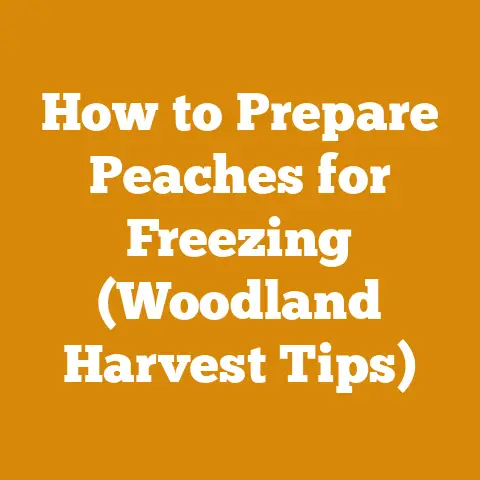Foundation Picnic Shelter: Best Base Options for Timber Frames (Expert Tips)
Imagine a lazy summer afternoon. Sunlight filters through the leaves, dappling the picnic table nestled beneath a sturdy timber-framed shelter. Laughter echoes, kids are running around, and the aroma of barbecue fills the air. This idyllic scene hinges on more than just good company and sunshine; it relies on a solid foundation. I’ve spent years working with timber, from felling trees in the crisp autumn air to meticulously crafting structures that stand the test of time. And let me tell you, the foundation of a timber-framed picnic shelter is where the rubber meets the road, or rather, where the wood meets the earth. Choosing the right base isn’t just about aesthetics; it’s about longevity, stability, and ensuring that your shelter remains a gathering place for generations. So, let’s roll up our sleeves and dive into the best foundation options for timber-framed picnic shelters, sharing some expert tips I’ve picked up along the way.
Foundation Picnic Shelter: Best Base Options for Timber Frames (Expert Tips)
The Crucial Role of a Solid Foundation
Before we get into the nitty-gritty of specific foundation types, let’s understand why a well-chosen foundation is so critical. A timber-framed structure, even a relatively simple one like a picnic shelter, exerts significant weight and force on the ground. Without a proper foundation, you’re looking at a host of potential problems:
- Settling and Tilting: Uneven ground pressure can cause the shelter to settle unevenly, leading to leaning posts and a generally unstable structure.
- Wood Rot: Direct contact with the ground exposes the timber to moisture, which is the enemy of wood. Rotting at the base compromises the structural integrity and shortens the lifespan of your shelter.
- Frost Heave: In colder climates, the expansion and contraction of frozen ground can lift and shift the shelter, causing damage.
- Insect Infestation: Ground contact provides easy access for termites and other wood-boring insects to feast on your timbers.
A good foundation mitigates these risks by:
- Distributing Weight: Spreading the load of the shelter over a larger area reduces ground pressure and minimizes settling.
- Creating a Barrier: Separating the timber from direct ground contact prevents moisture absorption and insect infestation.
- Anchoring the Structure: Providing a secure connection between the shelter and the ground resists wind uplift and other forces.
- Providing a Level Surface: Ensuring a flat, stable base for the shelter simplifies construction and improves its overall appearance.
Exploring the Best Foundation Options
Now, let’s get to the heart of the matter: what are the best foundation options for your timber-framed picnic shelter? Each option has its pros and cons, and the ideal choice will depend on factors such as soil conditions, climate, budget, and personal preference. I’ll walk you through several popular options, sharing my experiences and insights along the way.
1. Concrete Slab Foundation: The Gold Standard
A concrete slab is often considered the gold standard for timber-framed structures. It provides a solid, level, and durable base that effectively isolates the wood from the ground.
Pros:
- Excellent Stability: A concrete slab distributes weight evenly and provides a very stable platform.
- Superior Moisture Barrier: Concrete acts as a barrier against ground moisture, protecting the timber from rot.
- Level Surface: The smooth, level surface simplifies construction and ensures a plumb and square structure.
- Versatile: A slab can be finished in various ways, from a simple broom finish to decorative stamping or staining.
Cons:
- Higher Cost: Concrete slabs are generally more expensive than other foundation options due to the cost of materials and labor.
- More Labor-Intensive: Pouring a concrete slab requires excavation, formwork, and concrete mixing and finishing.
- Less Permeable: Concrete is not permeable, so rainwater runoff can be an issue if not properly managed.
My Experience: I’ve poured countless concrete slabs for timber-framed structures, and I can attest to their reliability. One project that stands out was a large pavilion for a local park. We poured a reinforced concrete slab with integrated drainage to prevent water from pooling around the base of the timbers. The extra effort paid off, as the pavilion has remained rock-solid and rot-free for over a decade.
Key Considerations:
- Soil Testing: Before pouring a slab, it’s crucial to have the soil tested to determine its load-bearing capacity. This will help you determine the necessary thickness of the slab and the amount of reinforcement needed.
- Reinforcement: Use reinforcing steel (rebar) or wire mesh to increase the strength and durability of the slab. The amount of reinforcement will depend on the soil conditions and the size of the shelter.
- Footings: In areas with frost heave, you’ll need to dig footings below the frost line to prevent the slab from cracking.
- Drainage: Ensure proper drainage to prevent water from pooling around the base of the slab. This can be achieved by sloping the slab slightly away from the shelter or by installing a perimeter drain.
- Expansion Joints: Include expansion joints in the slab to allow for movement due to temperature changes. This will prevent cracking.
Data Point: A properly poured and reinforced concrete slab can last for 50 years or more with minimal maintenance.
2. Concrete Pier Foundation: A Cost-Effective Alternative
Concrete piers offer a cost-effective alternative to a full slab, especially when dealing with uneven terrain. Piers are individual concrete posts that support the timber frame at specific points.
Pros:
- Lower Cost: Piers require less concrete and labor than a full slab, making them a more budget-friendly option.
- Adaptable to Uneven Terrain: Piers can be easily adjusted in height to accommodate sloping ground.
- Improved Drainage: The open space between piers allows for better drainage and airflow, reducing the risk of moisture buildup.
- Less Impact on the Environment: Piers require less excavation than a full slab, minimizing disturbance to the surrounding landscape.
Cons:
- Less Stable than a Slab: Piers provide less overall stability than a full slab, especially in areas with high winds or seismic activity.
- More Susceptible to Frost Heave: Piers can be more susceptible to frost heave than a slab, especially if they are not properly anchored below the frost line.
- Requires More Precise Layout: Piers require a more precise layout than a slab to ensure that the timber frame is properly supported.
My Experience: I used concrete piers for a picnic shelter project in a wooded area with a significant slope. We carefully positioned the piers to minimize excavation and preserve the natural landscape. We also used adjustable post bases to fine-tune the height of each post and ensure a perfectly level frame.
Key Considerations:
- Pier Spacing: The spacing of the piers will depend on the size and weight of the shelter, as well as the load-bearing capacity of the soil. Consult with a structural engineer to determine the appropriate spacing.
- Pier Depth: The depth of the piers should be below the frost line to prevent frost heave.
- Pier Diameter: The diameter of the piers should be sufficient to support the weight of the shelter.
- Post Bases: Use adjustable post bases to connect the timber frame to the piers. These bases allow you to fine-tune the height of each post and ensure a level frame.
- Backfilling: Backfill around the piers with compacted gravel to provide drainage and prevent erosion.
Data Point: Concrete piers can reduce foundation costs by 30-50% compared to a full concrete slab.
3. Gravel Pad Foundation: A Simple and Affordable Option
A gravel pad is the simplest and most affordable foundation option for a timber-framed picnic shelter, especially in well-drained soils. It involves creating a level pad of compacted gravel to support the timber frame.
Pros:
- Lowest Cost: Gravel is relatively inexpensive, and the installation process is straightforward.
- Excellent Drainage: Gravel provides excellent drainage, preventing water from pooling around the base of the timber.
- Easy to Install: A gravel pad can be installed with minimal tools and equipment.
- Permeable: Gravel allows rainwater to percolate into the ground, reducing runoff.
Cons:
- Least Stable: A gravel pad provides the least amount of stability compared to concrete slabs or piers.
- More Susceptible to Settling: Gravel can settle over time, requiring periodic maintenance to maintain a level surface.
- Requires Well-Drained Soil: A gravel pad is not suitable for areas with poorly drained soil or high water tables.
- Limited Lifespan: Without proper maintenance, a gravel pad may require replacement after several years.
My Experience: I used a gravel pad for a small picnic shelter in my own backyard. The soil was well-drained, and the shelter was relatively light. I compacted the gravel thoroughly and used pressure-treated lumber for the base of the frame to resist rot. It’s been standing strong for five years now with only minor adjustments needed.
Key Considerations:
- Gravel Type: Use crushed gravel with a mix of particle sizes for optimal compaction.
- Gravel Depth: The depth of the gravel pad should be at least 6 inches, and preferably 12 inches or more.
- Compaction: Compact the gravel thoroughly using a plate compactor or hand tamper.
- Edging: Use landscape timbers or other edging materials to contain the gravel and prevent it from spreading.
- Weed Barrier: Install a weed barrier fabric under the gravel to prevent weeds from growing up through the pad.
- Pressure-Treated Lumber: Use pressure-treated lumber for the base of the timber frame to resist rot.
Data Point: A well-maintained gravel pad can provide a stable foundation for a small timber-framed structure for 5-10 years.
4. Precast Concrete Blocks: A Modular and Portable Solution
Precast concrete blocks offer a modular and portable foundation option that is ideal for temporary or semi-permanent picnic shelters.
Pros:
- Easy to Install: Precast blocks are easy to install and require no special tools or equipment.
- Portable: The blocks can be easily moved and reused if the shelter needs to be relocated.
- Affordable: Precast blocks are relatively inexpensive.
- Good Drainage: The blocks allow for good drainage and airflow.
Cons:
- Less Stable than Concrete: Precast blocks are not as stable as a solid concrete slab or piers.
- Limited Load-Bearing Capacity: The blocks have a limited load-bearing capacity.
- Requires Level Ground: The ground must be relatively level for the blocks to sit properly.
- Aesthetic Limitations: Precast blocks may not be the most aesthetically pleasing option.
My Experience: I’ve used precast concrete blocks for temporary shelters at outdoor events. They are quick to set up and take down, and they provide a solid enough base for a lightweight timber frame.
Key Considerations:
- Block Size: Choose blocks that are large enough to support the weight of the shelter.
- Block Spacing: The spacing of the blocks will depend on the size and weight of the shelter.
- Leveling: Ensure that the blocks are level before placing the timber frame on top.
- Shims: Use shims to fine-tune the level of the blocks.
- Pressure-Treated Lumber: Use pressure-treated lumber for the base of the timber frame to resist rot.
Data Point: Precast concrete blocks can be installed in a matter of hours, making them a quick and easy foundation option.
5. Screw Piles: A Modern and Environmentally Friendly Choice
Screw piles are a relatively new foundation option that is gaining popularity for timber-framed structures. They are steel piles that are screwed into the ground using specialized equipment.
Pros:
- Minimal Site Disturbance: Screw piles require minimal excavation and site disturbance.
- Fast Installation: Screw piles can be installed quickly and easily.
- High Load-Bearing Capacity: Screw piles have a high load-bearing capacity.
- Suitable for Difficult Soil Conditions: Screw piles can be used in a variety of soil conditions, including unstable soils.
- Environmentally Friendly: Screw piles are a more environmentally friendly option than concrete foundations.
Cons:
- Higher Cost: Screw piles are generally more expensive than concrete piers or gravel pads.
- Requires Specialized Equipment: Screw piles require specialized equipment for installation.
- Less Common: Screw piles are less common than other foundation options, so it may be difficult to find a contractor who is experienced in installing them.
My Experience: I’ve seen screw piles used in a few timber frame projects in environmentally sensitive areas where minimizing site disturbance was a priority. The installation was quick and efficient, and the resulting foundation was incredibly strong.
Key Considerations:
- Soil Testing: Soil testing is essential to determine the appropriate size and type of screw piles.
- Pile Spacing: The spacing of the piles will depend on the size and weight of the shelter.
- Pile Depth: The depth of the piles should be sufficient to reach stable soil.
- Professional Installation: Screw piles should be installed by a qualified contractor.
Data Point: Screw piles can be installed in almost any weather condition, making them a reliable foundation option year-round.
Wood Selection for Ground Contact
Regardless of the foundation type, the wood that comes into closest contact with the foundation (or the ground, in the case of a gravel pad) is critical. I’ve seen too many beautifully crafted timber frames succumb to rot because of poor wood choices.
Pressure-Treated Lumber: This is the most common and cost-effective option for ground contact. The chemical treatment protects the wood from rot and insect infestation. Look for lumber that is treated for “ground contact” use.
Naturally Durable Wood Species: Some wood species, such as cedar, redwood, and black locust, are naturally resistant to rot and insect infestation. These species can be used for ground contact without chemical treatment, although they are typically more expensive than pressure-treated lumber.
Wood Preservation Techniques: Beyond pressure treating, other preservation techniques like borate treatments or applying penetrating epoxy sealers can significantly extend the life of wood in contact with the ground.
My Experience: I once built a small bridge using black locust for the posts that would be in contact with the ground. Even after decades, the locust posts were still solid as a rock, while the surrounding untreated wood showed signs of decay.
Data Point: Pressure-treated lumber can last for 20-30 years in ground contact, while naturally durable wood species can last for 50 years or more.
Safety First: A Word of Caution
Before you start building your timber-framed picnic shelter, remember that safety should always be your top priority.
- Wear appropriate safety gear: This includes safety glasses, gloves, and a hard hat.
- Use power tools safely: Read and follow the manufacturer’s instructions for all power tools.
- Work with a partner: It’s always safer to work with a partner, especially when lifting heavy timbers.
- Call before you dig: Before you start digging, call your local utility companies to locate any underground utilities.
- Consult with a professional: If you are not comfortable with any aspect of the project, consult with a qualified contractor or engineer.
Conclusion: Building a Legacy
Choosing the right foundation for your timber-framed picnic shelter is an investment in its longevity and stability. By carefully considering the factors I’ve discussed, you can select the foundation option that best suits your needs and budget. Remember, a solid foundation is the key to creating a gathering place that will be enjoyed for generations to come. From the satisfying thud of a hammer driving a stake to the quiet hum of a concrete mixer, every step you take in building your shelter is a step towards creating a lasting legacy. So, choose wisely, build carefully, and enjoy the fruits of your labor.






